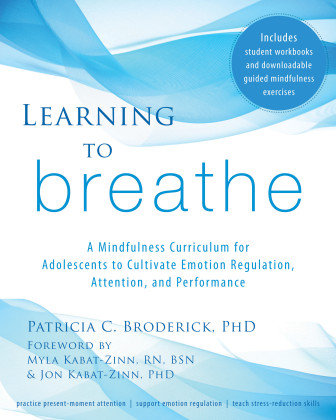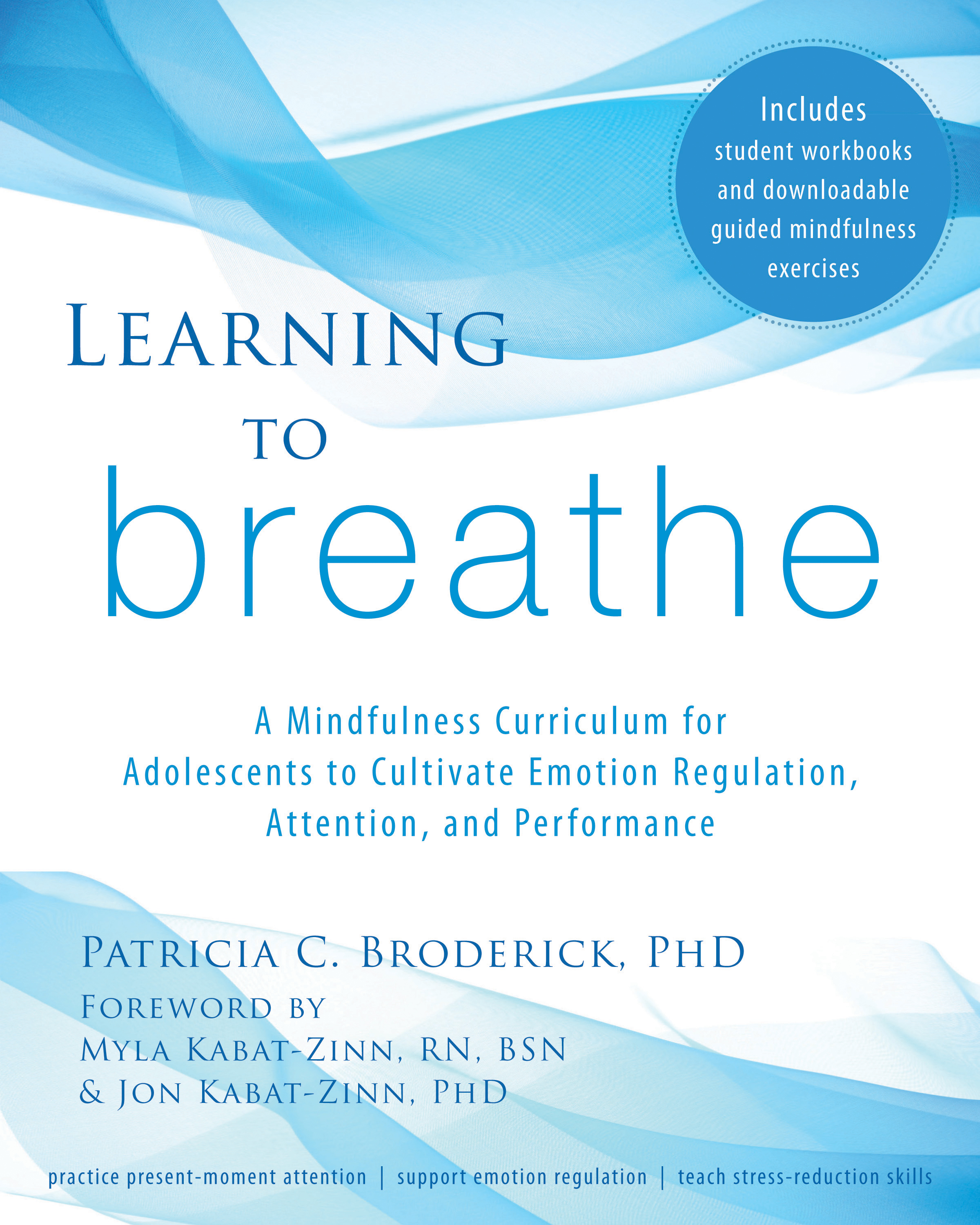 Learning to Breathe: A Mindfulness Curriculum for Adolescents to Cultivate Emotion Regulation, Attention, and Performance
Learning to Breathe: A Mindfulness Curriculum for Adolescents to Cultivate Emotion Regulation, Attention, and Performance
Patricia C. Broderick
New Harbinger Publications
266 pages
By Jami Jones
Patricia Broderick’s practical and research-based mindfulness curriculum “Learning to breathe” (L2B) benefits mental-health counselors and youth workers seeking to help adolescents gain control of their emotions. Broderick writes, “Research in this burgeoning area of study suggests that mindfulness offers great benefits to health and well-being by shifting the nature of our relationship to experience.”
L2B has roots in the Mindfulness-Based Stress Reduction (MSBR) program founded by Jon Kabat-Zinn at the University of Massachusetts Medical Center in 1979. The eight-week MSBR program that is offered in more than 200 medical centers, hospitals and clinics around the world cultivates greater awareness of the mind and body connection, and the negative impact of unconscious thoughts, feelings and behaviors that can undermine emotional, physical and spiritual health.
Broderick’s flexible and commonsensical curriculum makes many MSBR activities accessible to teens in school and after-school settings. L2B can be adapted by youth workers and parents whose goal is to support and positively impact emotional regulation, attention and performance through guided practice with adolescents. Broderick, a graduate of the University of Massachusetts’s MSBR program, is abundantly qualified to write this school-based curriculum. She holds a master’s degree in counseling, a Ph.D. in school psychology, and is professor emeriti, founder and former director of the Stress Reduction Center at West Chester University of Pennsylvania. Today Broderick works as a research associate at the Penn State Prevention Research Center.
The practice of mindfulness shifts cognitive focus away from the past and the future to the present and provides a powerful tool for restoring emotional balance and preventing harmful behavior. Broderick clearly articulates the importance of mindfulness practice for teens, explaining that happiness and well-being are more than mastery of content knowledge and test performance progress through the educational system but rely on a host of interpersonal, intrapersonal and problem-solving skills.
Beyond a good education, learning to attend to productive tasks, to remain motivated when work becomes demanding and to handle the frustrations of sharing, learning and communicating are skills requiring the ability to understand and manage emotions. The ideal outcome for an individual is to handle both positive and negative feelings without resorting to chronic repression or tuning out on the one hand or chronic acting out in aggressive or self-destructive ways on the other.
Broderick describes mindfulness as the “opposite of being ‘zoned out,’ asleep, in denial, or unaware of what’s happening. It is open, moment-to-moment awareness, held without judgment, even when what is occurring may be unwanted.” Broderick contends that mindfulness offers great benefits to health and relationships by shifting the nature of relationships to the present rather than ruminating on past or future events that are out of our control.
The L2B consists of six themes that form the acronym BREATHE: Body, Reflections (thoughts), Emotions, Attention, Tenderness (take it as it is), Habits for a healthy mind. The overall program goal — the ending E — is Empowerment. L2B’s focus is “attention, as opposed to specific content, is the core curriculum.” Although there is a structure to the lessons and activities, the focus on this curriculum is present-moment awareness “by slowing down and practicing a new skill set for paying attention.”
“Learning to breathe” is organized into four parts. In Part One, Broderick describes the need for mindfulness in education and the benefits of the BREATHE curriculum. In Part Two, Broderick presents the curriculum in a six-session format that is well-suited for work with younger adolescents or when time is limited. In Part Three, Broderick presents an 18-week format well-suited for older adolescents or when ample time is available. For each weekly BREATHE session, several activities and practices are identified, thus providing ample content to tailor programs for particular groups of adolescents and school venues.
An example of a mindfulness activity is the raisin activity first described in Kabat-Zinn’s book “Full Catastrophe Living: Using the Wisdom of Your Body and Mind to Face Stress, Pain, and Illness.” In this activity, participants eat three raisins with a mindful approach, noticing their texture and sensations occurring in the mouth. At the beginning of each L2B lesson, adolescents practice a three-minute body scan to notice stress or tension. Starting from the feet, participants move their attention through the body, noticing tension and breathing deeply to relax. This is a practice that Broderick encourages adolescents to do before tests, a job interview or any activity that requires focus and a relaxed state.
Part Four offers supplementary information, such as a description of adolescent challenges and opportunities, a primer on health and developmental dangers of stress, sample assessments for determining the effectiveness of mindfulness programs, and L2B student workbooks.
Broderick anticipates readers’ concerns that a mindfulness-based curriculum such as L2B might be a hard sell in test-driven educational systems by listing laws and standards, such as No Child Left Behind and the National School Counseling Standards that this curriculum addresses. In the book’s foreward, Kabat-Zinn and Myla Kabat-Zinn address the importance of mindfulness in learning: “Even great musicians have to first tune their instruments. It is the same with learning. For many students, before they can engage fully in the more academic aspects of the curriculum, they may first need to tune their own ‘instruments’ by learning how to pay attention and then sustain attention over time.”
Resources
Broderick’s website learning2breathe.org provides additional resources to strengthen emotion regulation skills in teens, including research studies and projects about social and emotional learning and specifics about the BREATHE curriculum.
Jon Kabat-Zinn has written several groundbreaking, must-read books on mindfulness: “Full Catastrophe Living: Using the Wisdom of Your Body and Mind to Face Stress, Pain, and Illness” (2013, revised) and “Wherever You Go, There You Are” (2005).
Many excellent workbooks and manuals focus on mindfulness and the adolescent, providing a variety of activities and strategies for teens to deal with stress. “The Stress Reduction Workbook for Teens: Mindfulness Skills to Help You Deal with Stress” (2010) by Gina Biegel and “Just One Thing: Developing a Buddha Brain One Simple Practice at a Time” (2011) by Rick Hanson are well-regarded resources. Hanson is the author of several other books on brain science, mindfulness and meditation.


























